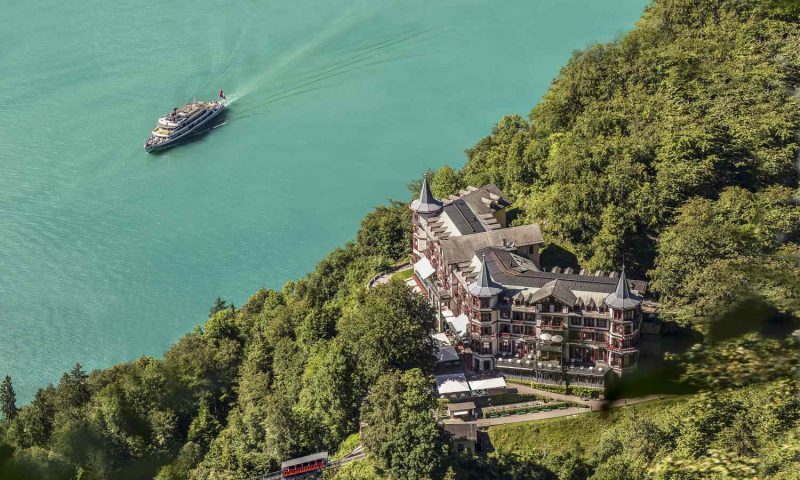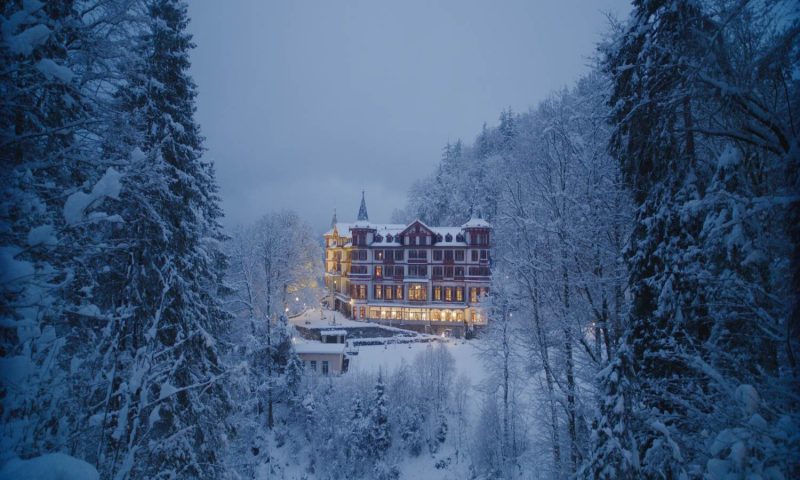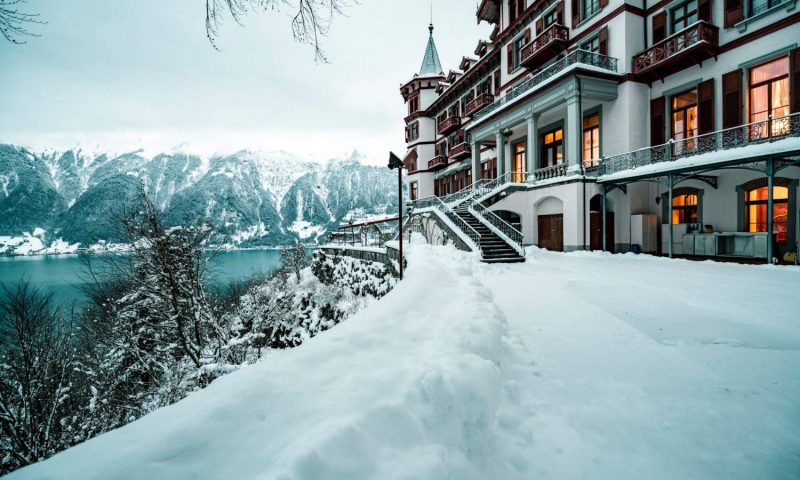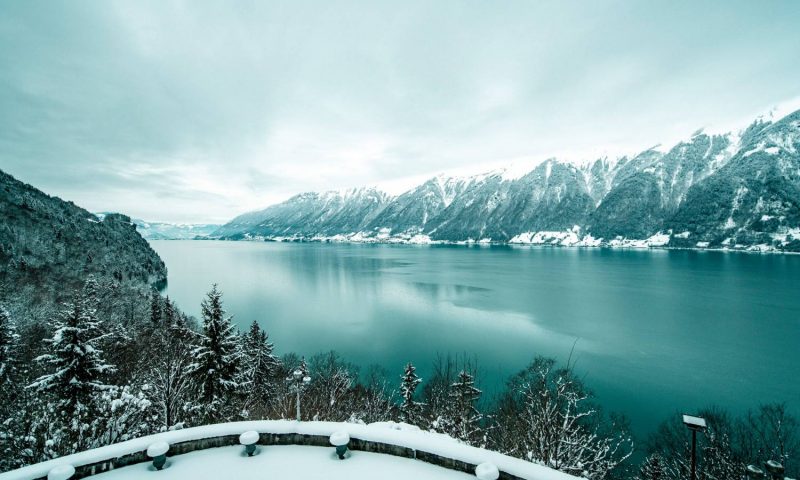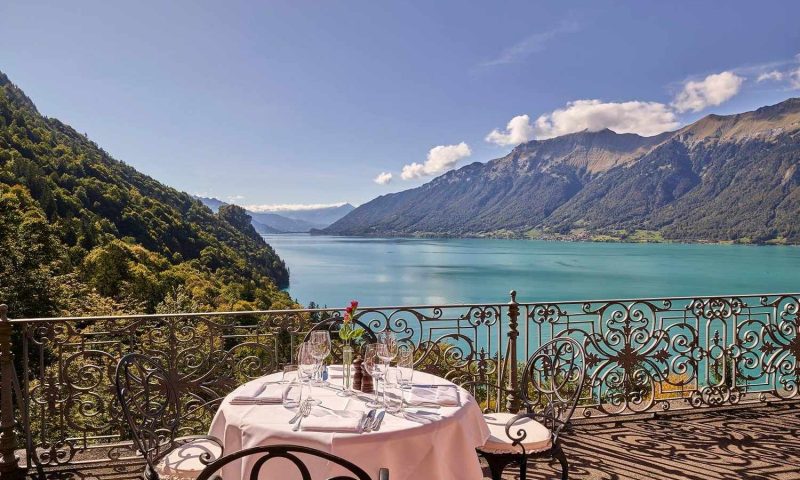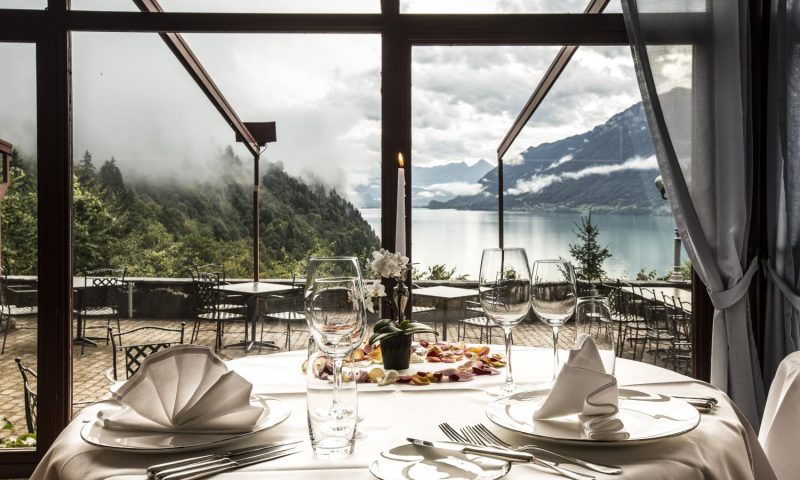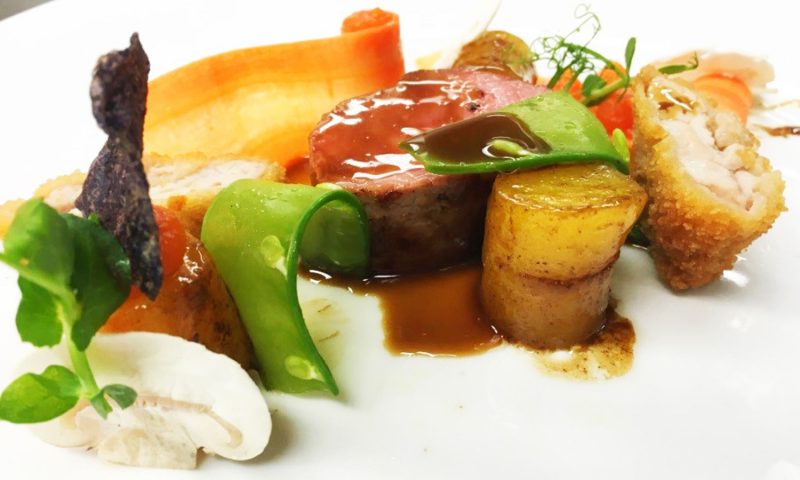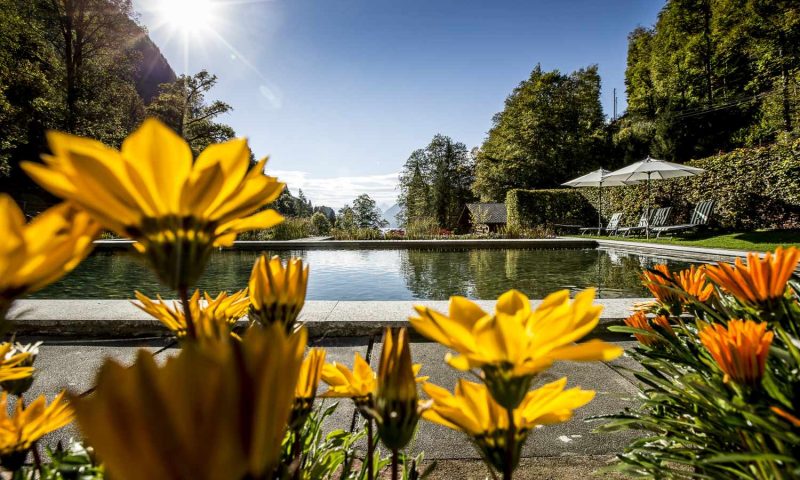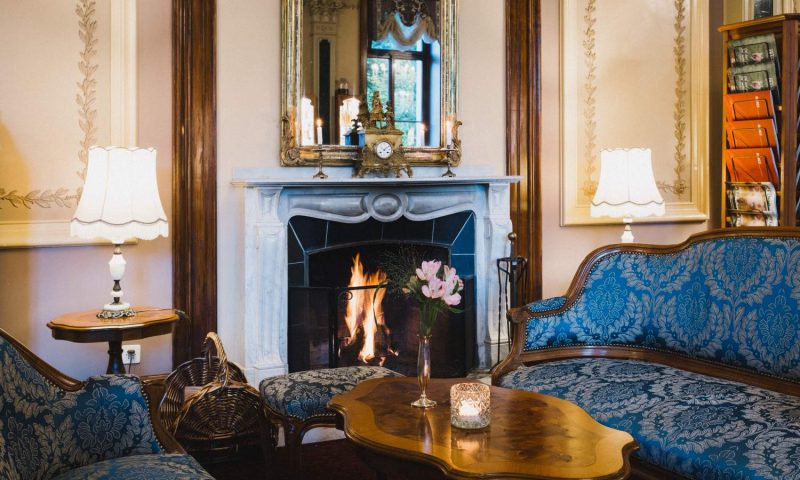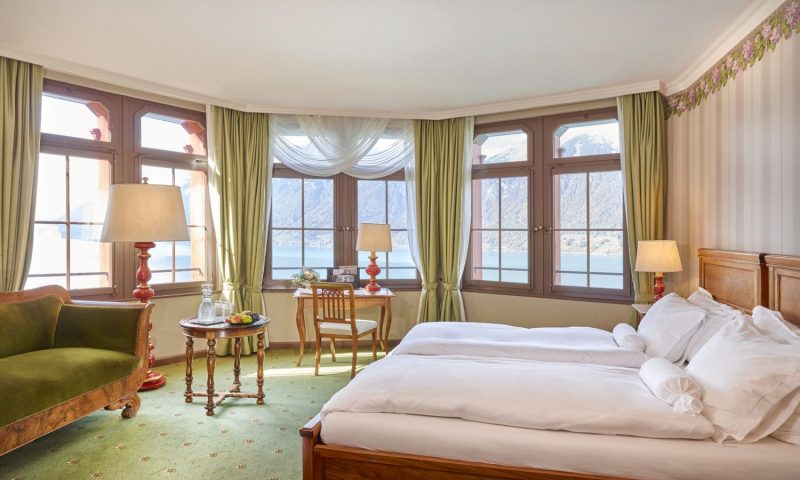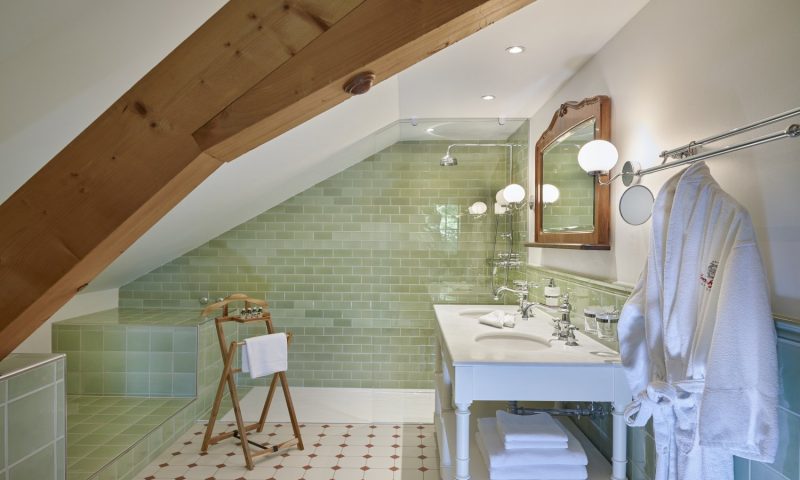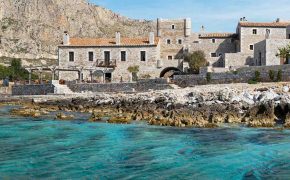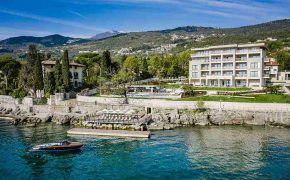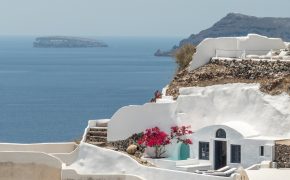Welcome to the Grandhotel Giessbach. A hotel steeped in history, a place of peace and vitality. A place to breathe freely, to enjoy the gifts of life, to re-energize. Architecture, nature, respite for the senses and spirit; indulgence for body and soul. A gift of nature and of time that has withstood the years, a place of joy and peace that transcends time.
In many respects, we live in a fast-paced age. But at the Grandhotel Giessbach, the pace slow and time forms its own little bubble. The wonderful location, the water, and the views converge to form our genius loci, the protective spirit of place. At the Grandhotel Giessbach, the sense of time is different.
It is deeper, more precious, more intense. Whether in your room, in the historical spaces, the library, or the dining rooms, the moment is to be savoured. Time is here and now, complemented by a range of culinary delights and a beautiful view of the depths of Lake Brienz to appreciate. Treat yourself to an interlude at this extraordinary spot.
THE HISTORY
In 1873-5 the well-known Hauser family of hoteliers, from Wädenswil in the Canton of Zurich, commissioned the French architect Horace Edouard Davinet with the construction of the Grandhotel Giessbach. The elegance of its architecture blended in with the beauty of the surroundings and thus the hotel quickly became a worldwide attraction.
Painters, engravers, and photographers depicted the enchanting unity of buildings, gardens, and landscape. Poets, writers, and musicians sang the praises of the natural wonders of the Giessbach Falls. Until the First World War broke out in 1914, the Grandhotel Giessbach was a meeting place for the great and the famous.
Royals and aristocrats and their entourage, leaders, statesmen, diplomats, and celebrated artists spent their summers at Giessbach, gaining new strength and exchanging society gossip and state secrets.
Two World Wars plus economic crises with their devastating consequences for the Swiss hotel industry combined with a different understanding of tourism led to the fading of the lustre and glory of the Giessbach.
After many years of decline, the hotel closed its doors in 1979. There were plans for it the entire original complex to be demolished and instead to erect a modern concrete building in the style of a ‘Jumbo Chalet’.
It was fortunate that in November 1983 the internationally renowned Swiss environmentalist Franz Weber managed, with the help of his association Helvetia Nostra and the ‘Giessbach to the Swiss People Foundation’, to purchase the Giessbach estate with its 22 hectares of land and to have it listed as a heritage site. His idea to ‘give’ Giessbach to the Swiss people and thus keep it intact for all time met with an enthusiastic response from the population.
GIESSBACH SUITE
Elegance meets spectacular vistas: 25 square metres of private terrace belonging to the Giessbach Suite offers a breathtaking and unforgettable view of the Giessbach Falls and Lake Brienz. Invigorating mountain air, sunsets for romantics and existentialists alike. To the left, a waterfall, sometimes murmuring, sometimes roaring, a constant reminder of what Nature means.
GIRON SUITE
The Giron Suite and the Salon Giron on the Bel Etage of the Grandhotel Giessbach are named in honour of Swiss portraitist and landscape painter Charles Giron (* 2 April 1850 in Geneva; † 9 June 1914 in Genthod (Canton of Geneva).
Giron had begun an apprenticeship as an enameller, but decided not to pursue this and instead took up lessons with François Diday and Barthélemy Menn. In 1872, he moved to Paris, where he worked for the studio of Alexandre Cabanel, and studied at the École des Beaux-Arts.
In 1876, he exhibited his works at the Paris Salon. Giron devoted much of his work to landscape and portrait painting. He lived in many places, including Cannes, England, Belgium, and the Netherlands.
In 1887, he was awarded the Order of Leopold from the Kingdom of Belgium. A year later, he was awarded the French Legion of Honour. In 1896, Giron returned to Switzerland and went to live variously at several spots by Lake Geneva.
His most famous work is his 1902 mural “Die Wiege der Eidgenossenschaft” (“The Cradle of the Confederation”), which is displayed in the National Council chamber of the Bundeshaus parliament building in Bern.
At the Grandhotel Giessbach, Giron’s large-scale “Schwingfest in den Alpen” (Wrestling Festival in the Alps) can be admired in the salon that bears his name. It is his largest canvas painting.
Guests staying in the Giron Suite will be struck by the large windows overlooking the forest, lake, and town of Brienz. The suite thus naturally highlights the awe-inspiring landscape of the Giessbach.
HORACE EDOUARD SUITE
The light and airy Horace Edouard Suite offers a splendid view of Lake Brienz. It is named after the Swiss-French architect Horace Edouard Davinet (* 23 February 1839 in Pont-d’Ain; † 30 June 1922 in Bern). After the death of his mother, Davinet spent much of his time living in Bern. In 1856, he began an apprenticeship with his brother-in-law Jakob Friedrich Studer.
Alongside Studer, he was involved in the design of the Bundeshaus (the parliament building) and the Bernerhof luxury hotel in Bern. He also worked on the new hotels in the Bernese Oberland, the Grandhôtel Giessbach on the shores of Lake Brienz, and the Jungfraublick in Interlaken.
HAUSER SUITE
The Hauser Suite earns its name from the well-known family of hoteliers, the Hausers, who bought the “Giessbach property” in 1870. Karl Hauser commissioned the most celebrated hotel builder of the time, Horace Edouard Davinet, to design a new building: a five-storey palace hotel.
Davinet promptly set about building a five-storey construction with domed towers in the “Louvre” style, and a sweeping flight of steps. After two years of construction, the hotel opened in 1875.
DINING
From the excursion destinations we recommend to the places our kitchen ingredients come from, the Grandhotel Giessbach is shaped by the local region and honours this heritage with great respect.
Many farmers and local producers contribute to the well-being of the hotel guests with their produce. This deeply rooted connection with the land bears the hallmark of Franz Weber and constitutes one of the most subtle forms of environmental protection there is.
Culinary delights and guest well-being are of course of paramount importance to the Giessbach restaurants. We would like to see all guests enjoying both, far removed from the strains of everyday life.
We are guided by the conviction that this happens most successfully when we produce as much as we can ourselves. We cook in harmony with the seasons and with nature. It is well known that freshly harvested products simply taste the best.
So, we pick herbs from our own kitchen garden; as far as possible, we grow vegetables in our own fields, and sometimes in our historical greenhouses. Even our honey comes from Giessbach bees. We source our wines exclusively from Europe and fetch our water from our very own spring.
THE LEGACY OF GOOD FOOD
One important aspect of the Grandhotel Giessbach is its close connection with the surrounding region. From the excursion destinations we recommend, to the places we procure our kitchen ingredients, the Grandhotel Giessbach has always been shaped by the local region and honours this heritage with great respect.
Many farmers and local producers contribute to the well-being of hotel guests with their produce. This deeply rooted connection with the land bears the hallmark of Franz Weber and constitutes one of the most subtle forms of environmental protection there is—the produce comes directly from the region and is not sourced from far-flung countries.
LES CASCADES PARKRESTAURANT & TERRACE
Our main restaurant, the park restaurant “Les Cascades” can accommodate up to 140 people and offers a beautiful view of the Giessbach Falls. When the weather is fine, lunchtime service takes place on the Le Tapis Rouge terrace overlooking the turquoise-blue Lake Brienz.
KEHRLI TERRACE
The Kehrli Terrace is the new lunch restaurant of the Grandhotel Giessbach. It invites you to have lunch on the large park terrace. We will spoil you with summery and traditional dishes from our Giessbach kitchen.
You can order and pay quickly and easily via QR code at the table. If required, our service team will continue to be at your full disposal. All food and drinks will continue to be served comfortably to your table.
ATELIER RESTAURANT LE TAPIS ROUGE
Executive chef Lukas Stalder and head chef of Le Tapis Rouge Barbara Blaser are responsible for the signature and profile of the natural and playful studio kitchen. All those who are curious and enjoy food can let themselves be seduced at the Le Tapis Rouge and discover so far unknown culinary highlights.
Home-grown and local are the top priorities at the Le Tapis Rouge. Enjoy the diversity of the Giessbach Garden, the Giessbach Herb Garden and the Domaine Giessbach and be surprised by what nature has to offer during your visit. The restaurant Le Tapis Rouge is awarded 14 Gault Millau points.
THE BAR
Nostalgia and the world of Swiss spirits. From the recommended excursion destinations to the origin of the products used in the bar: The Grandhotel Giessbach is supported by the region and pays respect to this heritage. This deep rootedness carries the legacy of Franz Weber and embodies one of the most subtle forms of environmental protection.
Nostalgia and origin combined. As the starting and ending point of every successful evening, the hotel bar in the middle of the Belle Etage exudes pure nostalgia and tradition. Combining nostalgia and regionality is one of our most important principles. So enjoy our varied selection of Swiss spirits and cocktails alongside a selection of bar classics from around the world.
THE KIOSK
The kiosk is located directly at the upper station of the Giessbach funicular. We look forward to welcoming you from May to mid-October. We are happy to provide you with snacks and drinks at the kiosk. Enjoy the view of the Giessbach Falls and pick out a souvenir to remember your trip. Open: Daily 10 a.m. to 5 p.m.
THE BREAKFAST
The morning feast in the Salon Belle Epoque. Enjoy the legendary breakfast buffet with a view of the waterfall and start the day invigorated. A wide selection of breakfast drinks, regional meats, cheeses and breads await you. Enjoy the sunny balconies of the Salon Belle Epoque in good weather.
WEDDINGS & EVENTS
With lively celebrations and heady thoughts, an instant is immortalised; night turns into day; a day is lived in a heartbeat. The Grandhotel Giessbach is an unrivalled venue for weddings, celebrations, anniversaries, birthdays, christenings and family gatherings—and also seminars, conferences and workshops.
Whatever event you are planning, if you plan it with us, it will be nothing short of unforgettable. Our historical rooms each have their own special charm and have delighted visitors and guests for nearly 150 years. We look forward to hosting you. To enjoy your occasion to the fullest, we recommend booking a room to make the most out of your time at the Grandhotel Giessbach.
NATURAL SWIMMING POOL
Our natural swimming pool is completely free of chemicals such as chlorine, making the water particularly soft and pleasant on the skin. The water is purified by circulating the bathing water through thick layers of gravel in the regeneration zone.
The plants inhabiting the regeneration zone bring life into this system. They also absorb the nutrients contained in the water, which considerably reduces unwanted algae growth.
The natural swimming pool is only open to hotel guests and is a wonderful place for sunbathing as well as swimming. It is home to over 300 newts in the springtime. At the start of the season, these newts are transferred to a large pond near Brienz. Their presence is a sign of just how pure our bathing water is.
NATURPARK
The longing for nature is becoming ever greater. Unspoilt experiences in the nature park of the Grandhotel Giessbach are possible at any time of year. The energy of the waterfall, the trees and the rock formations never ceases to amaze. In any light and at any time of year, the sight provides breathtaking moments that invigorate the mind and soul.
The Giessbach Foundation takes great care of the entire complex and the surrounding forests in order to preserve this lifeline for future generations. Enjoy moments of closeness to nature, and enjoy the power that is created. It is a total work of art from the earth and the rock that is unparalleled.
THE WATER
Water is life. Water is the pure elixir we yearn for. The life-affirming energy exuded by the Grandhotel Giessbach is fed by the power of water. The Giesse Stream, with its waterfall, cascading into the depths of Lake Brienz. The Grandhotel Giessbach is surrounded and sustained by the restorative power of water.
THE GIESSBACH FALL
The Giessbach Falls tumble right past the Grand Hotel in 14 tiers, plunging 400 metres into the depths in thunderous cascades of white. Various trails run along the waterfall. From the Giessbach funicular station, one can also admire it from above.
At night, this natural spectacle is highlighted to powerful effect by recently installed illuminations. In autumn, the falls are enveloped in an interplay of splendid hues, while in spring, the melting snow and the rain swell the stream to spectacular proportions.
HISTORICAL PLANTS
The Grandhotel Giessbach opened its doors in 1875. Since 2014, its gardens have been graced with ornamental plants that reflect the plants of that time in history.
These plants are from the collections of the ProSpecieRara Foundation, which campaigns to preserve and protect ornamental and useful plants that are endangered. The gardens present three collections: the dahlia collection, the hydrangea collection, and the astilbe collection.
On the viewing terrace, our shady spots offer the ideal habitat for the 39 varieties of hydrangeas and for the 16 varieties of astilbes planted beneath the hydrangeas.
Some of the varieties found here are very old, such as the Thomas Hogg hydrangea from 1876 (dating back to the Belle Époque, like the Grand Hotel itself). There are also well-known Swiss varieties that are very hard to come by now.
The dahlias bloom from July to October, enjoying our sunniest positions. 30 varieties, including the oldest variety still available, the White Aster (1879), can be admired here in all their glory.
These collections are indeed a window into a bygone age, but they are also extremely important for safeguarding the future of these varieties. ProSpecieRara regularly checks the plants, documents their development, and thus ensures their conservation.
GIESSBACH FUNICULAR
As part of the maintenance work on railroad technology and carriages prescribed by the Federal Office of Transport, carriage 1 had to be flown out in winter 2019/20, the chassis dismantled and, like the carriage body, completely overhauled.
The work provided an opportunity to look into the history of the carriage. The cable railway at Giessbach, which opened in 1879, was epoch-making in that engineer Roman Abt designed the switch in the middle especially for it, thus making the previous double-track systems obsolete.
In the case of the Giessbachbahn, the previous system would also have meant building the entire 190m-long bridge twice as wide. After Giessbach, construction of double-track cable railways ceased abruptly. The new system immediately prevailed due to its economic efficiency!
Unfortunately, the Abt turnout of 1879 had technical deficiencies, which however could be repaired in 1891 during a reconstruction. These defects had also damaged the carriages that they had to be replaced by the present one. These currently used carriages are thus 130 years old! In their long life so far, the car bodies have been repainted several times.
Therefore, it was obvious to have a restorer establish by probings which colour clothes had been put on the carriages in the past. The results are clear: at first, the carriages were painted in the reddish, brownish-yellow hue of the Swiss wooden style, just like the hotel when it was rebuilt after a fire in 1884.
Since this transparent treatment, which allowed the wood tone to show through, was not repairable, an opaque coat in a rich green shade was then applied to the carriages. We assumed that, as with the first carriages of 1879, friezes (frames) and fillings were kept in a different colour.
It is this second version that we have now applied; it probably dates back to the time of the major renovation of the hotel in 1912, the colour scheme of which still characterises the house today.
A further coat of paint was applied perhaps after 20 years, this time in a light blue/grey tone. Only later, probably in 1947/49, did the cars receive the first coat of red paint. Since car 2 will be renovated later, but in the foreseeable future, we will have to get used to a red and a green car meeting each other on Abt’s switch.
